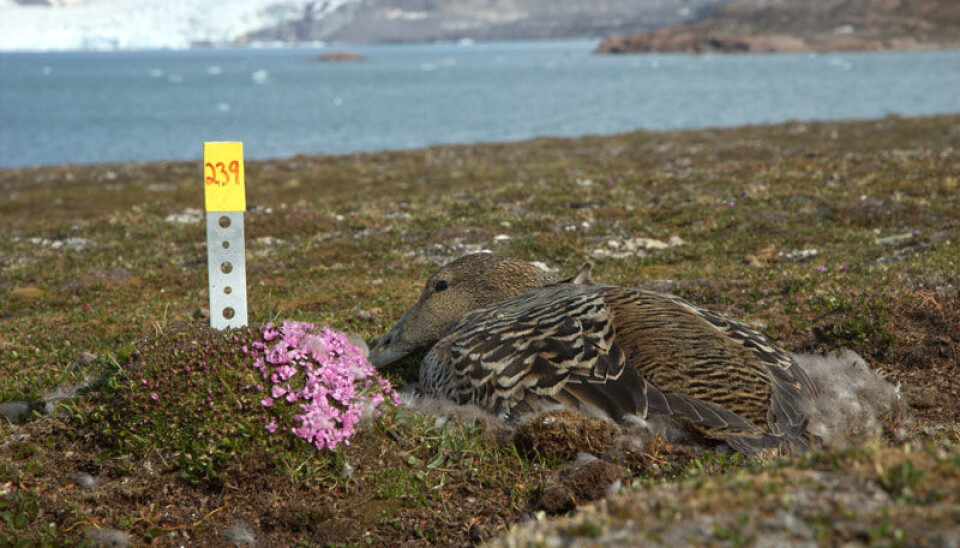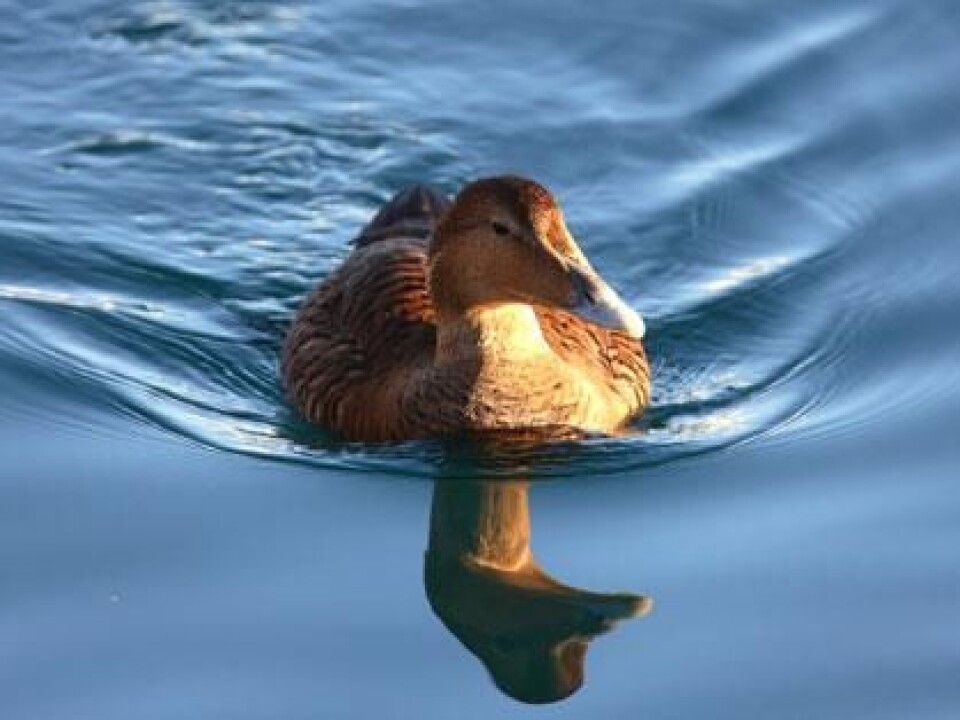
Yo-Yo dieter with eiderdown
The common eider is a yo-yo dieter. This can make the sea duck vulnerable to environmental toxins and disease both on the Svalbard Archipelago and along the Norwegian coast.
Denne artikkelen er over ti år gammel og kan inneholde utdatert informasjon.
The eider is a faithful and appreciated member of the Norwegian coastal fauna. When the nesting season starts in a few weeks – the time varies in different parts of the country – females go in for a serious diet.
“Ea” is the name many coastal dialects use for the female eider.
She does all the nesting by herself and doesn’t eat the entire period until her eggs hatch. This fast consumes all the reserves of fat she has stored.
“The female starves for 25 days. Towards the end of the period the sea duck starts metabolizing the proteins in her muscles,” says researcher Sveinn Are Hanssen from the Norwegian Institute for Nature Research (NINA).
Can lose 40 percent
As much as 40 percent of its body weight is lost during the nesting period.
Hanssen and his colleague Børge Moe have studied the vulnerability for environmental toxins and disease associated with this nesting strategy.
Eiders are also found on Svalbard, the island group far north or Norway, and researchers have compared the health condition of nesting eiders there with those on the mainland.
The project was part of the International Polar Year (IPY) research cooperation.
NINA researcher Hanssen submitted results from the research at a conference in Tromsø last week that marked the end of the Norwegian contributions to IPY.
Eiders at Grindøya near Tromsø and at Kongsfjorden on Svalbard were selected for the study. Blood samples were taken throughout the nesting period to gauge the eiders’ health condition.
The female eiders’ strategy of building up a reserve of fat to have something to go on during hard times is used by many arctic animals.
However, a number of environmental toxins, including PCB, are stored in fatty tissue. When the fat is metabolized these poisons are released and can harm the animal and they can be found in blood samples.
The researchers discovered that a variant of PCB and two other environmental toxins increased in blood samples significantly after 15 days of starvation.
This increase comes at a point when the birds are stressed, vulnerable and their resistance is down. The amounts of these toxins in eiders were much higher in Tromsø than on Svalbard but they increased for both stocks during the nesting period.
Parasite flora
In addition to the gradual loss of their bodies’ storage of energy reserves, the eiders were susceptible to parasites.
One of the ways the birds get these is by eating crabs and crustaceans. The parasites make lesions in their stomachs and intestines, rob them of nutrients and can cause disease.
One eider in Tromsø had no less than 23 nematodes (round worms), 613 flukes, 24 tapeworms and152 acanthocephala (spiny-headed worms) in its stomach and intestines. The latter have a hook on one end that they use to attach themselves to the intestinal wall of the host.
Researchers don’t consider such a high number of parasites unusual.
“This was an eider that appeared to be completely healthy. This is probably an average level of parasites,” says Hanssen.
The eiders are believed to partially shut down their immune system during the nesting period. This allows them to use less energy to stay healthy and more of their fat reserves can be spent protecting and warming the eggs.
At the same time a reduced immune system can lead to larger mortality rates.

Interplay
Scientists see that environmental toxins and parasites both affect the birds’ health, so human impacts play a role together with natural factors.
Along large stretches of the Norwegian coast the eider is a non-migratory bird. This means it is a resident, summer and winter. In other regions it migrates.
Few eiders stay for the winter at Svalbard. The monitoring of the stock at Kongsfjorden, which is on the west coast of Spitsbergen, shows that it splits up in the winter.
“A third of them fly south to North Norway and two thirds fly to Iceland,” says Hanssen.
Not an easy trip
The journey from Iceland to Svalbard is no holiday.
“The eider doesn’t like to fly long distances. It simply flies and gets its over with. The migration only takes a couple of days,” says Hanssen on the phone from Svalbard.
The first eiders are currently arriving on Svalbard and the goal is to catch as many birds as possible that are marked with so-called light logs.
Light logs are a kind of “flight record” that the eider carries, attached to a leg. They store information about where the bird has travelled.
Hanssen explains that the little capsule weighs just 1.5 grammes and is not believed to affect the bird’s behaviour in any negative way.
Researchers now want to find out if choice of winter residence has any impact on the levels of environmental toxins they store. Is there a difference between the ones who choose Iceland rather than the Norwegian mainland?
“We don’t yet know if it is the same birds that fly to Iceland every year,” says Hanssen.

--------------------------------
Read article in Norwegian at forskning.no
Translated by: Glenn Ostling






























